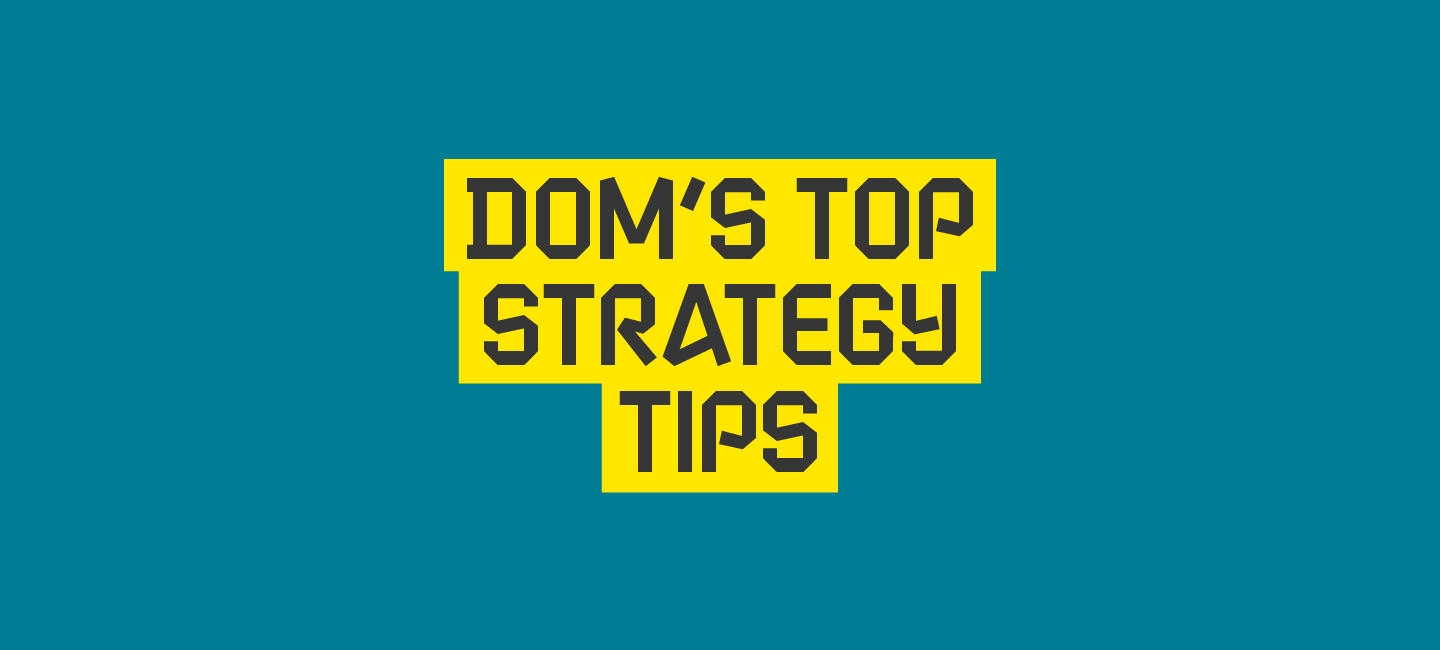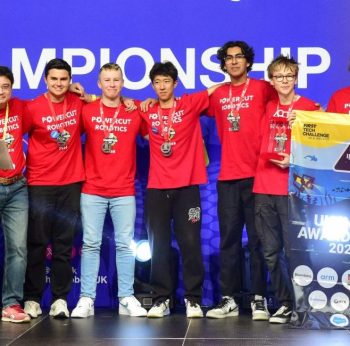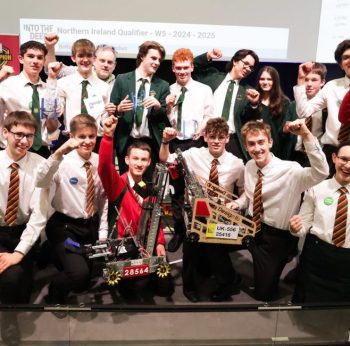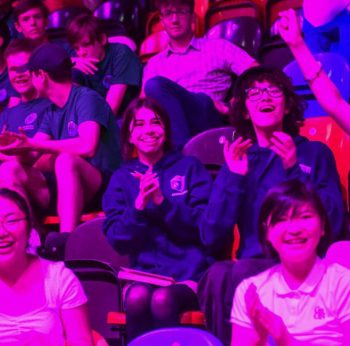
Dom’s strategy tips
We asked a Dom, previous Strategy Officer from the Binary Bots team in London, what tips and tricks they would pass along to help other teams when planning their season. They had lots to say, so takes some time to make sure you’re familiar with what’s involved in an effective strategy plan!
. . .
Watch the Kick-off video
The first thing your team should do is to sit down together and watch the video explaining this year’s game. The video won’t tell you everything that you need to know, but it gives a good overview of all of the ways to score points in a game.
Watch the Kick-off video, again
The game reveal video will often present a lot of information very quickly, so it’s important that you watch it more than once. After your team has watched the video for the first time, take a few minutes to ask each other questions about anything you didn’t understand. Then, watch the entire video once more, so that you really understand what is happening in each phase of the game. The second time you watch the video, you can focus on anything that confused you before, and you’ll have a clearer idea of how the game works before looking deeper into the different ways to score points.
Read the scoring summary
Now that you have a clear picture of the game, find the Scoring Summary in the Game Manual, Part 2. Your entire team should take the time to read and understand how many points each task is worth, as this will be critical when deciding your strategy for the season.
Note: As the Strategy Officer, it is your responsibility to know all of the rules as they are written in the game manual, so that your team doesn’t accidentally build a robot or devise a strategy that is illegal. It is a good idea for your entire team to read all sections of the manual, especially if you are new to FIRST Tech Challenge, so that everyone understands how the competition works.
List everything you can do
At this point, it can be useful to take some time to list everything your robot can do for each phase of the game. An action that your robot does won’t necessarily score points directly — you should include actions such as picking up game pieces, bringing game pieces to an alliance partner, and defending as well as point-scoring actions. Have your Document Controller start three lists (one for Autonomous, one for Tele-Op, and one for Endgame), and record ideas from your teammates about everything you can do in each phase. Some actions may seem obvious, but it will be very helpful to be able to see all the possible actions you can have your robot do.
| Game phase | Action | Number of cycles per game | Points per cycle | Points per game (# of cycles x points per cycle) |
| Autonomous | Auto task 1 | |||
| Autonomous | Auto task 2 | |||
| Autonomous | Auto task 3 | |||
| Tele-Op | Tele-Op task 1 | |||
| Tele-Op | Tele-Op task 2 | |||
| Tele-Op | Tele-Op task 3 | |||
| Endgame | Endgame task 1 | |||
| Endgame | Endgame task 2 |
Completing one “cycle” means that your robot has done the entire task, and returned to the position they were in at the start of a cycle. For example, if the task is to pick up a game piece, one cycle would be driving to the game piece, picking it up, then driving back to the starting position. Determining how many cycles you can complete in a game can be tricky. Some tasks can only be completed once, so you can do one cycle per game. For repeatable tasks, like picking up game pieces, you will have to use your best judgement to estimate how long one cycle would take and use this to determine how many cycles you could complete in an entire game. The “number of cycles per game” assumes that this is the only thing your robot will do for the whole game, so there’s no need to factor in the time that other tasks would take.
An example of a completed scoring table can be seen below:
| Game phase | Action | Number of cycles per game | Points per cycle | Points per game (# of cycles x points per cycle) |
| Autonomous | Auto task 1 | 2 | 5 | 10 |
| Autonomous | Auto task 2 | 1 | 10 | 10 |
| Autonomous | Auto task 3 | 1 | 15 | 15 |
| Autonomous | Auto task 4 | 1 | 20 | 20 |
| Tele-Op | Tele-Op task 1 | 6 | 1 | 6 |
| Tele-Op | Tele-Op task 2 | 4 | 3 | 12 |
| Tele-Op | Tele-Op task 3 | 3 | 5 | 15 |
| Endgame | Endgame task 1 | 1 | 10 | 10 |
| Endgame | Endgame task 2 | 1 | 25 | 25 |
Rank the tasks by points per game
Once you have a completed scoring table, you can use your results to rank each tasks from the most points per game, to the least points per game. Using the example table above, we would get the following ranking:
1. Endgame Task 2
2. Auto Task 4
3. Auto Task 3, Tele-Op Task 3 (Tie)
4. Tele-Op Task 2
5. Auto Task1, Auto Task 2, Endgame Task 1 (Tie)
6. Tele-Op Task 1
After a full session discussing the best strategy for your team, you’re now ready to move on to designing, prototyping, and building the mechanisms that your team has deemed the most important. With some hard work, you’ll be racking up points at the competition in no time!
Create a priority list
Now that you’ve picked what tasks you want to focus on, you can write your priority list! Your priority list will rank your robot’s mechanisms from most important to least important. This can be really helpful if two mechanisms are conflicting with each other. You might realise during the season that you don’t have enough parts to build both, or that one stops the other from working, so you can use your priority list to cut or change the design of the less important mechanism. Your priority list should prioritise the mechanisms you need the most in order to complete the tasks you decided on. For example, if your most important task is picking up a game piece and lifting it into a high goal, then you should prioritise a mechanism to pick up the game piece, then a mechanism to lift that game piece. An example priority list can be found below.
1. Drivetrain
2. Mechanism 1
3. Mechanism 2
Note: You can’t do anything without driving, so building a good drivetrain should always be the first item on your priority list.
Talk as a team
It’s up to you and your team to use these results however you see fit. It may seem obvious that Endgame Task 2 is what you should focus on, but you also should keep in mind how difficult each task will be. If Endgame Task 2 will require multiple mechanisms and be very difficult to build, it might be worth focusing on the second or third highest ranking tasks, especially if you are a new team. This is where your list of everything your robot can do is really helpful — you can piece together all of the actions that you would need to do to complete each task. This will give you a good idea of what mechanisms you will need to build to complete each task. On another note, if you decide to prioritise Auto Task 4, it is a good idea to choose a Tele-Op or Endgame task next, so that you can continue to score points for the remainder of the game. It can also be helpful to think about what tasks would use the same mechanisms as other tasks that you have already prioritised. For example, if you prioritised Auto Task 4, and you have to pick up a game piece to complete that task, it is a smart idea to prioritise a Tele-Op task that also relies on picking up game pieces next. Ultimately, you and your team should use the information from your ranking, as well as your common sense about what you will be able to build in a season, to decide which tasks you want to focus on.
Start Building!
After a full session discussing the best strategy for your team, you’re now ready to move on to designing, prototyping, and building the mechanisms that your team has deemed the most important. With some hard work, you’ll be racking up points at the competition in no time!
. . .
Want to know how Dom and the team approached creating their strategy in 2019? Read Dom’s blog about lessons learnt from season 2018-19.



